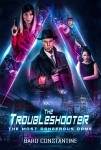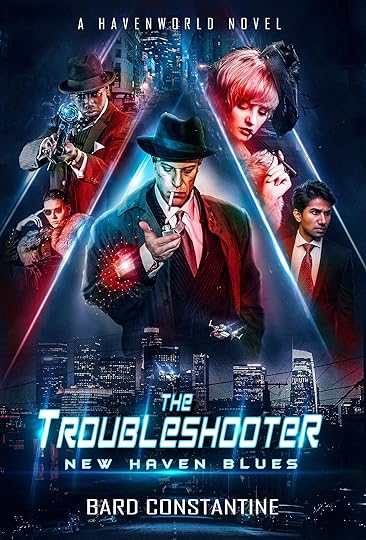Lewis Knight's Blog
November 1, 2022
Autumn Update
Where has the year gone? Two more months to go? Wow. Well, if you’re like me, then you’ve probably been busy dealing with the daily insanity of what passes for life right now. Hopefully, things are going as well as possible, and I truly hope the rest of the year will be filled with more ups than downs. Personally, my work schedule has been very hectic, making it difficult to get much writing done as I planned. But the good news is that progress is being made on the third installment of the Shadow Battles saga, The Wayward Crown. It’s been a long time coming, and I’m very excited to get back into my fantasy world.
So, what does that mean? I hope to have Wayward Crown finished by the Spring of ’23 if all goes well. In the meantime, I’ve been posting a ton of visual content on my Facebook author page and Instagram, so be sure to drop by and check out depictions of all my characters and settings, from the Havenworld novels to the Shadow Battles books. AI art has been a tremendous boon to creating work I otherwise would never have been able to produce, and I will continue to post new art for you to view. So, if you’ve ever wondered what the characters of your favorite books look like in my mind, be sure to check them out! I’ve posted a few examples below to give you an idea of what the art looks like.
In other news, this week is Troubleshooter Week, so you should dive in now if you haven’t had a chance to check out that series. It’s a complete series of four action-packed books and the introduction to the Havenworld universe. Take your favorite private eye tropes, put them in a Blade Runner-styled world, throw in some femme fatales, bourbon, and bullets, and let the fireworks explode. The first novel is free, and the rest are marked down this week only!
That’s it for the moment. I’ll be sure to drop an update at the year’s end, but for now: be excellent to each other. See ya soon.
All the best,
~Lewis K
Troubleshooter Week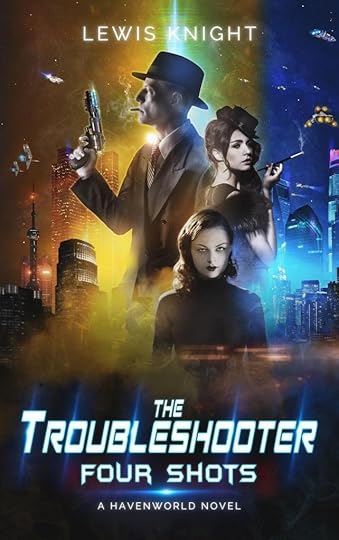 Troubleshooter Week starts with the first installment of the action-packed series. Be sure to pick up your free copy on Kindle, then check out the rest of the series. You won’t regret it!Get Now!SAMPLE IMAGE GALLERY, CHECK INSTAGRAM FOR MORE!
Troubleshooter Week starts with the first installment of the action-packed series. Be sure to pick up your free copy on Kindle, then check out the rest of the series. You won’t regret it!Get Now!SAMPLE IMAGE GALLERY, CHECK INSTAGRAM FOR MORE!
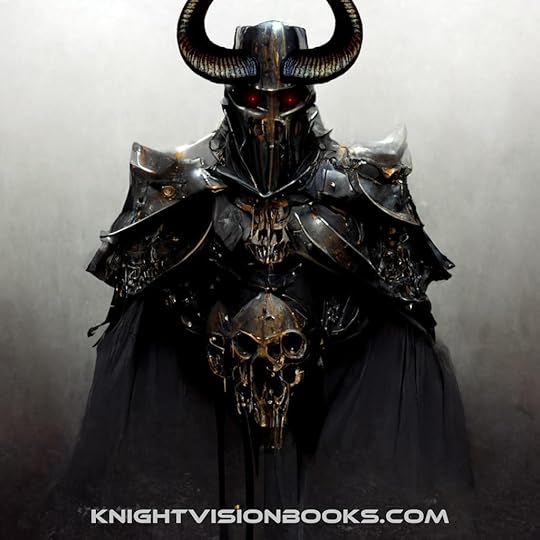
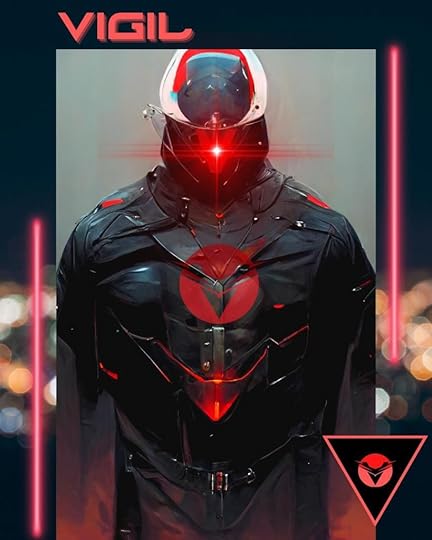
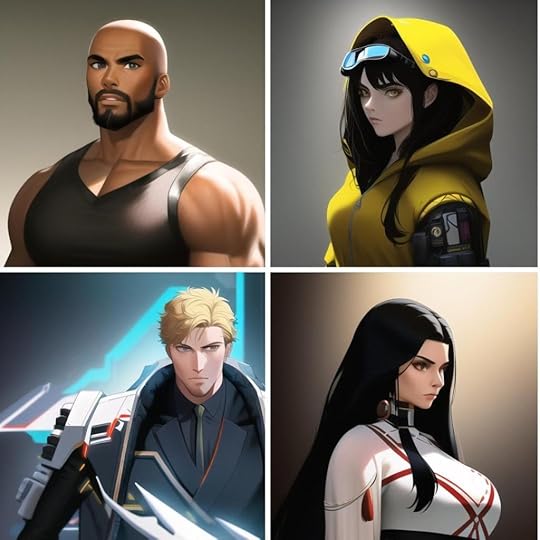 Reaper illustration, Vigil card, Vigil Family: Jett, Mira, Arthur, Qhawa
Reaper illustration, Vigil card, Vigil Family: Jett, Mira, Arthur, Qhawa
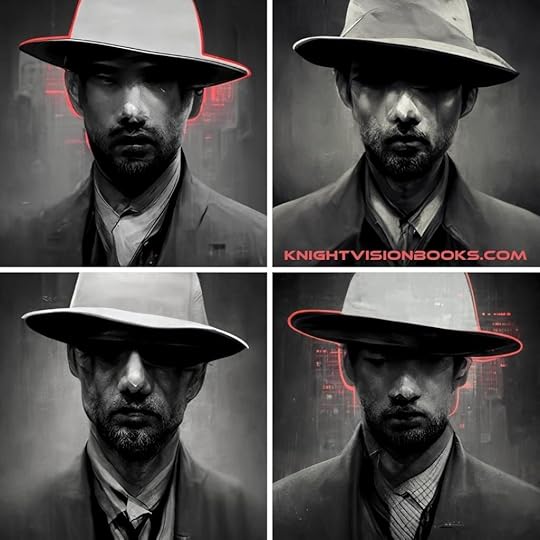
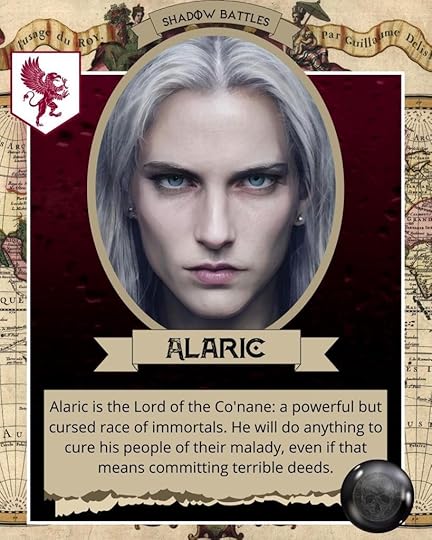
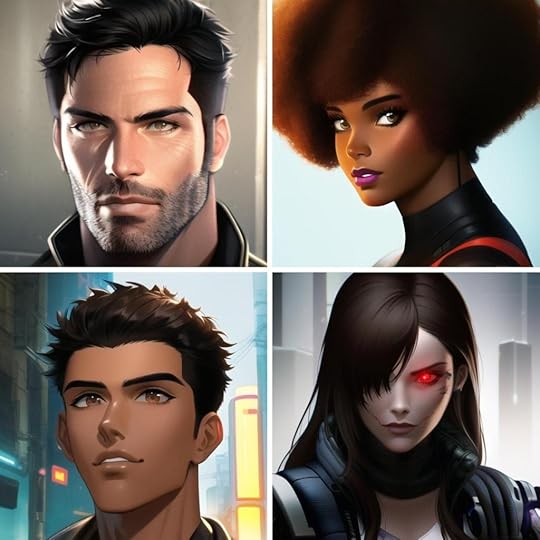 Mick Trubble collage, Alaric Card, B-Team: Cash, Jinx, Mateo, Happy
Mick Trubble collage, Alaric Card, B-Team: Cash, Jinx, Mateo, Happy
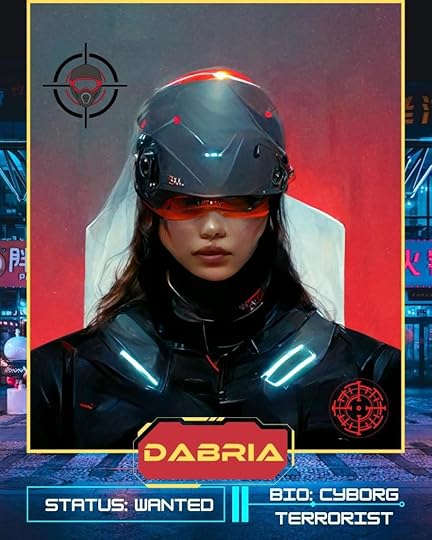
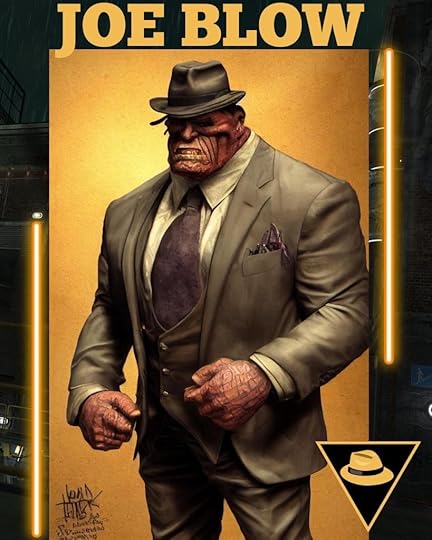
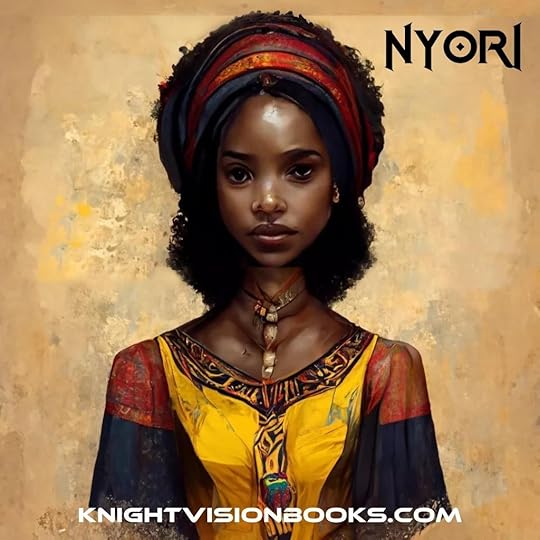 Dabria card, Joe Blow card, Nyori illustration
Dabria card, Joe Blow card, Nyori illustrationWant to see more? Check the Instagram page!
August 30, 2022
Midjourney Book Title Game #1
To get me back into blogging and in view of my newfound enthusiasm for Midjourney art, I thought I’d have a little fun.
The rules: Type in the title of a series/book title and see if the results match the book in any way. Then of the four results, pick the one that most resembles the theme of the book. I’ll start with one of my book titles: The Eye of Everfell.
No other prompts, no alternate versions. The results:
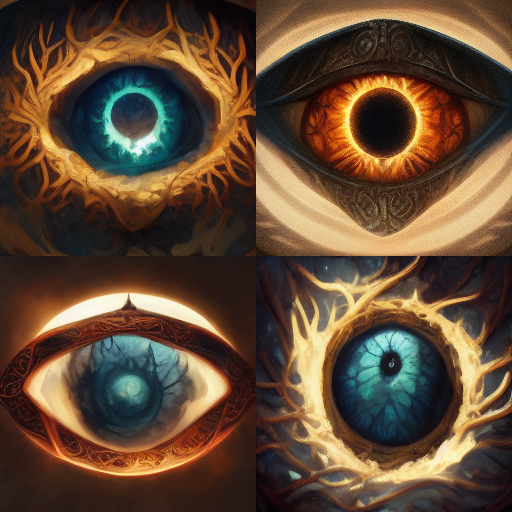 Eye see you
Eye see youAnd hey: nice results! The AI seemed to guess at a fantasy theme, which is correct. Of the four, I like number two the best. Interestingly enough, it even matches up nicely with an excerpt from the book:
“Time and erosion had long obscured the statue’s features, but the Eye remained, centered in the statue’s forehead. In place of the iris was a dimly glowing orb around the size of Nyori’s face. As she drifted closer, it appeared cloudy, as if to envelop the secrets it held within. The swirling haze dissipated at her touch, the orb effused with a warm glow.”
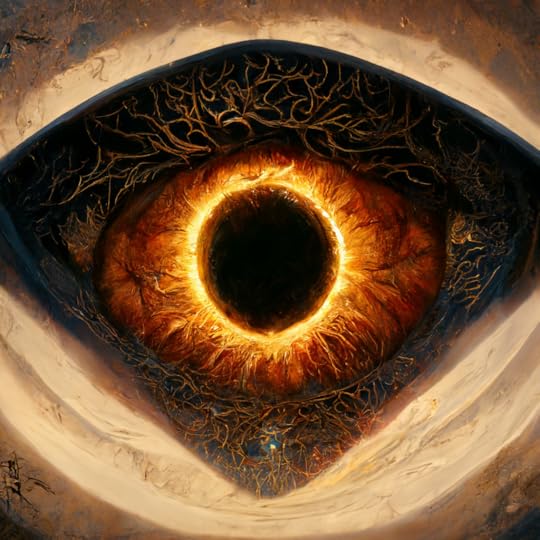 A little Sauron-ish, if you ask me
A little Sauron-ish, if you ask meWell, that was fun. Let’s do this again sometime! And hey, if you want to play, just follow the rules and tag it #midjourneybooktitlegame
Actual Eye of Everfell cover plus link:
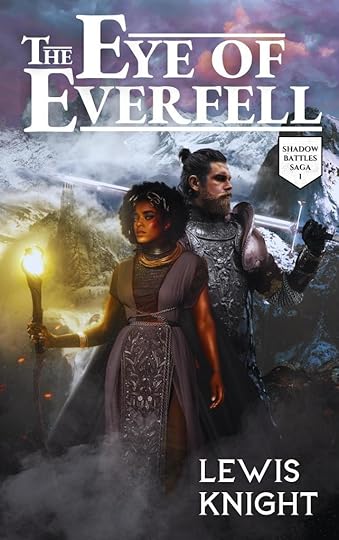 Hey, I don’t see anything resembling an Eye of Eveerfell anywhere!
Hey, I don’t see anything resembling an Eye of Eveerfell anywhere!
August 29, 2022
Midjourney AI Art: Destroyer of Worlds?
I’ve been experimenting with Midjourney for a few weeks now, so it’s time to write about the experience. First of all, I’m well aware of the controversy surrounding AI art generators, as I’m acquainted with more than a few artists, most of who despise their very existence. And I get it; we’re talking about livelihoods being threatened. Every person who turns to an art generator for a project is potentially a customer who might have used a human artist instead. So, if you’re income is dependent on commissioned work, you’d be alarmed at the very least at the idea of losing bids to a soulless machine. I certainly don’t want to be insensitive to those concerns because there’s a very valid discussion about usage rights, intellectual properties, copyrights, etc. It’s a Wild West atmosphere with AI art right now, reminiscent of the start of the cryptocurrency boom. Will AI art end up on the same roller coaster ride of extreme highs and lows? Only time will tell.
But make no mistake: AI generators are here to stay. The dam has burst, and there’s no way to stop the torrent now. I personally believe that artists are less threatened than they imagine because there will always be those things that can’t be generated randomly or by carefully written prompts. What separates digital from human are the intangibles, the things not easily expressed but understood because, well … that’s what makes us human.
But returning to the subject: Midjourney. It’s been my favorite of the various apps and programs I’ve tried, other than Artbreeder, which is much more limited. (I’ll probably do a blog on Artbreeder later.) How does Midjourney work? Keeping it simple, you type in a prompt, and it produces art accordingly. Example:
Evil knight in black armor fighting monk in robes with glowing swords and fiery background
And the result:
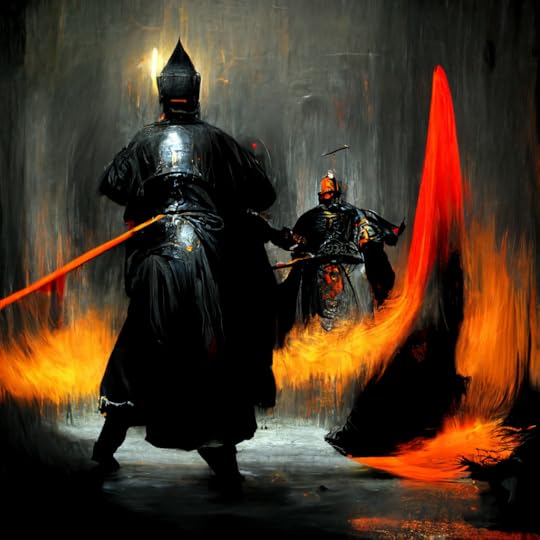 ‘Tis a flesh wound.
‘Tis a flesh wound.Yeah, not too impressive. I didn’t think much of it, as several other attempts resulted in even worse results: ugly features, nightmare eyes, clunky results. I nearly gave up entirely, but I knew the program had to be solid because other people were producing art that looked way better than I was getting. So, I did what artists and writers have done since art existed: look at what someone else did and steal it. Which, ironically, is what the whole uproar over AI art is about. But anyway, what I mean is look at other people’s prompts, copy them, and adjust according to my needs, kind of like writing HTML code back in the day. So, I went from drab, ugly results to being able to generate something that actually looked pretty cool. Midjourney works best when pointed to a style to imitate, such as Unreal Engine. Case in point:
Dystopian town, old Western, dusty and rusty, ancient steel mill in center, style of unreal engine
And the result:
 Almost looks good
Almost looks goodNow, I was on to something. But to get even better results, the key is detailed prompts, then using the Version and Upscale options to keep tweaking and chiseling down the results until you get the best version. Granted, it can get tedious, but I have no complaints. I mean, look at what can happen when you get your prompts right. Here is a trio of my latest results:
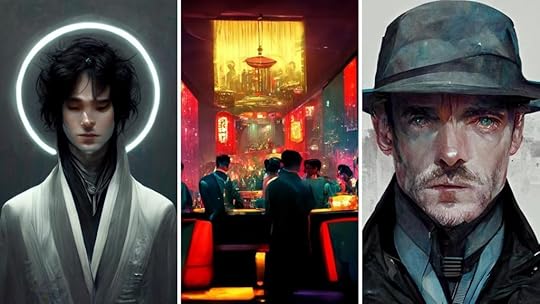
The results are literally limitless once you get the hang of it. Of course, the above results were achieved with prompt changes, upscaling, and version spawning. But the results speak for themselves. In a few weeks, I’ve generated three hundred twenty-five jobs at the time of this writing. I’m not sure if MJ counts each image as a job, or each prompt, because I didn’t bother to count all the images I’ve generated. It’s a lot. But the value as a tool for concept creation is priceless. I can literally generate anything in my imagination, so long as I can write the proper prompts and tweak the results.
And therein lies the threat to the artist community.
So, let’s crack this down. Let’s say I want to create a slew of concept art for my novels. Heck, let’s just say one series. Getting one of the pieces above commissioned by an artist will run anywhere from one to three hundred dollars, and that’s probably being generous. I have an absolute slew of characters, not to mention environments and locales. Take the Troubleshooter series. To commission concept art for that series alone would probably run three grand or more were I to want to post enough art for a comprehensive wiki or my dream project: The Visual Guide to the Troubleshooter. Do I have that kind of money lying around for dream projects? Of course not. Sure, I can commission a single piece every couple of months and be able to complete the project in a decade or so. Good luck with that, right? So, what happens? Nothing, it’s just a dream. All the crazy visuals in my mind can only be described on the page, and then I sit back and imagine what it would look like in art form. Every now and then, I see a sliver of artistic representation on a book cover. Other than that, it all stays interior.
Until now.
I’m on the deluxe version of Midjourney, which is forty dollars a month. Think about it: for forty dollars, I can go to an artist, tell him what I want, trash any version not to my liking, and have him perform endless tweaks and variations until I’m satisfied. Then do it again, endlessly, any time of the day or night, any day of the week. My artist is never closed, never sleeps, never dodges emails, and never gets back to me when he’s good and ready. He just produces endlessly, for forty dollars a month. They even have a ten-dollar version that limits your minutes but is still great for someone on a super-tight budget. It’s a dream come true.
Or is it?
You know the saying about something being too good to be true, right? Well, it definitely applies here. So, here are some obvious drawbacks, not counting the litigation/legal side of things, which will no doubt be handled in the months and years to come. First, don’t make the mistake some rookies are making right now: assuming the work you ‘created’ belongs to you.
It doesn’t.
How can you own something you didn’t create? Do you own the program or have any part of its conception? We’re talking about something that takes prompts from random people, spews it online for anyone to see, and does nothing to make it private or impede it from being downloaded by anyone who comes across it. That’s right, the instant the AI generates an image, it can be downloaded by anyone. Sure, there’s a ‘private’ feature, but that just hides the prompt, not the image. Don’t believe me? Go to anyone’s profile or generated image, enlarge it, right-click, and download. At that point, anyone can claim someone else’s picture for themselves and use it however they want to, with no repercussions. Stealing, you say?
Digital laughter echoes all around.
You can’t steal something you don’t own. And inherently, that’s the major and serious drawback of anyone who thinks they can use these amazing images for anything beyond common online usage. It’s not yours. It belongs to no one. You can’t copyright it. Sure, people are doing that right now. The same people that sell clothing and art online featuring obviously stolen work have been doing it for years. But if you’re interested in staying on the legal side of things, you should definitely be aware of the drawbacks and dangers of such ventures, especially if you’re thinking of using them for your intellectual properties. Bottom line: use at your own risk, and don’t go into it blindfolded. Keep up with the latest because everything is bound to change at a moment’s notice.
So, if legal usage is limited, what good is it? Personally, I’m just getting a kick out of producing visuals for all of my books. I now have unlimited pics to share on my social networks, allowing readers to see what I see and dive deeper into the worlds I’ve created. To me, that’s worth the monthly charge. I’m content to wait until everything shakes out before trying to use it for commercial projects. As I said earlier: get used to AI art. I see a lot of loud hate posts from some of my artist peers, as if the whole thing will disappear the more they complain about it. It’s a bit ironic, especially from digital art communities. Weren’t the same accusations about killing real art thrown at them by traditional artists at the dawn of the new tech? And like then, that couldn’t be further from the truth. Art never dies; it just adapts. And no matter the legal challenges, this train won’t stop anytime soon. In fact, it’s just getting started. Like all technology, this will become another avenue, another tool in the box. Whether one adapts or not is entirely up to them.
Some final thoughts:
I hear artists complain about AI generators stealing art, which I don’t understand. I have yet to see an artist or anyone else give a solid example of any such thing. Does it imitate other artists? Of course it does. ARTISTS IMITATE OTHER ARTISTS. All the time, in fact. And that’s a great thing. For example: for my cover to the Darkest Champion, I showed the artist a piece done by Gerald Brom and told him this is basically what I want, just with my characters. And he delivered, as that remains my favorite cover out of all my books to this day. But is it stealing from Gerald Brom? Of course not. Look at all the artists who copped Frank Frazetta’s style in fantasy art, Jim Lee’s style in comic books, or any other popular artist in any medium. Art is basically one artist stealing from the next and making it their own, creating a cycle of growth and improvement. There are a lot of problems with AI and the threat to artists’ jobs, but the accusation of stealing styles doesn’t hold water, in my opinion. If someone can prove actual theft, please enlighten me, and I’ll gladly change my opinion.
Speaking of Frazetta, I constantly try to get Midjourney to create in his style, but the AI just can’t do it. All I get are strange mutations that the program should be embarrassed to produce. The same goes for Gerald Brom, which shows some of this tech’s limitations. You’re not going to get everything you want, and that’s a good thing. Another hurdle: action scenes. Midjourney is great with still images, but it just can’t do action for anything. Trying to produce battle scenes or even two characters interacting is a serious pain. Same for trying to detail multiple characters. Maybe I need to improve my prompts, but it’s been a wash so far. In fact, the more details I want, the less likely MJ will deliver them. Will this improve? We’ll see, but I’m doubtful it will ever get to the point of producing action scenes that will satisfy completely, especially when you have a dozen or more characters that all need to look a certain way. Getting one character’s design right is work, much less multiple ones.
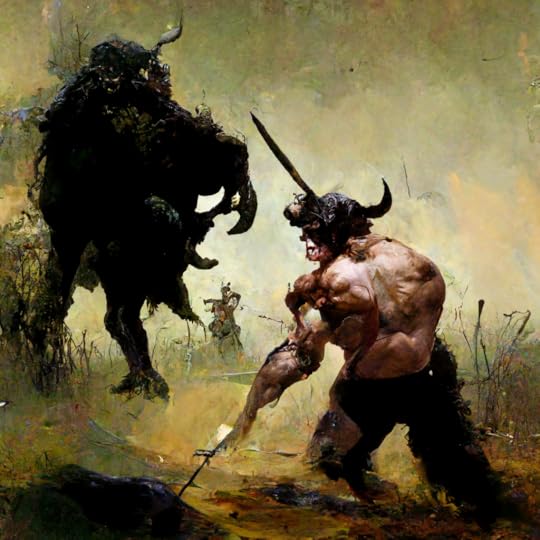 Prompt: warrior fighting minotaur with battle-axes, muscular, swamp background, frank frazetta, concept art. Seriously??!!
Prompt: warrior fighting minotaur with battle-axes, muscular, swamp background, frank frazetta, concept art. Seriously??!!So, what’s the future of AI art generators like Midjourney? The main thing creators immediately want is a true private mode, where only they have access to their creations. I think a version will eventually feature that and charge per download, like a stock photo site. It’s easy to envision something like that, and things will eventually calm down. I’d be happy to pay for the downloads I want, along with a license for commercial use. At that point, art generators will definitely compete with artists, for good or bad. Still, as I mentioned earlier, it will have its drawbacks and limitations, allowing human artists to continue to thrive in areas where they are superior. I will continue to use real artists for book covers in the future, but now I have a powerful tool for promotional, concept, and inspirational use. Best of both worlds, in my opinion.
What about you? Are you an artist, author, or anyone else impacted by this new tech? Let me know what you think in the comments. And if I offended any artists by my statements, please accept my apologies. I know this is a controversial issue, and I seriously don’t want to trivialize your feelings on the matter. This is just my opinion and not meant to be divisive. See you in the creative cosmos,
~Lewis K
March 23, 2022
A GIFT FOR FANTASY FANS
It took a lot longer to rebrand under my real name than I thought. I won’t bore you with all the details, but replacing every online image, changing every cover and manuscript, and then re-editing every book is a slog. Thankfully, that’s over now. And I want to celebrate by giving away The Eye of Everfell eBook for free.
Why give it away? Because I’m putting in a lot of effort to finish this series, with the third installment in development now. Anyone who loves epic fantasy in the style of Robert Jordan or Brandon Sanderson will enjoy this series as well. It’s packed with action, adventure, high stakes, and epic worldbuilding. If you want the full synopsis, it’s here.
What if I already own it? You’re still going to want the latest version. Some changes have been made, including a few names and minor plot developments. It’s all for the better, I promise. So, if you want the rest of the novels to make complete sense, best to pick this up for another read. And if you purchased this in print before the relaunch and want a replacement, just respond to this email and I’ll get you fixed up at no charge.
What if I don’t like fantasy novels? Well, that just hurts my soul, but I understand. Here’s a little secret: the website has two other novels available for free downloads. You can check those out here. Just don’t tell anyone.
Just kidding, I don’t care.
What if I don’t read ebooks? Unfortunately, I can’t give paperbacks away for free. But if that’s your preference, let me know and I’ll ship you a copy for half-off the Amazon listed price. How’s that?
So, what’s the catch? There isn’t one. Eye of Everfell is yours for free in eBook format, and you don’t have to do anything but download it. No newsletter signups, no info harvesting, no tricks. If you’d like to share the link to your social media, I’d greatly appreciate it. And if you’d like to leave an honest review afterward, it would make me insanely happy as well. But that’s entirely up to you. My main hope is that you enjoy the revised edition and hopefully be excited for the rest of the series.
All the best,
~Lewis KGET YOUR COPY!
January 9, 2022
What’s in a Name Part II
It’s been over a decade since I began writing under . Many things have changed since then, and at long last, I feel that the name should as well. Ever since the pandemic originally wrecked my creative drive, output, and publishing schedule, I’ve had time for a lot of time for reflection. What I’ve accomplished on my publishing journey, the mistakes I’ve made, and where I want to go now that I’m back in the saddle. The first thing on the agenda is reissuing my fantasy series and working on completing the saga. But it didn’t take long to realize the novels weren’t the only thing I wanted to revamp.
After extensive consideration, I’ve decided to rebrand my work under my real name: Lewis Knight. As I stated on other social media, I’m a little apprehensive but mostly excited. It’s all about ownership and taking the business side more seriously. And to be honest, I’m a bit tired of the pen name and feel it’s the perfect time to retire it for good. In a way, it’s coming back full circle to when I first started my first novel. On the mock cover, there was my name in bold, magnificent letters. It felt good then, and it feels even better now because I have a catalog of titles to put my name on. My name, not a pen name created by a moody writer of poetry. In a world where branding is king, it makes good sense to market myself for who I am.
So it’s goodbye to Bard Constantine and hello to Lewis Knight. I plan on being much more active media-wise and much more marketing-savvy from here on out. Despite the circumstances of pandemic insanity, I feel energized and ready to see what 2022 has in store. And no matter how the chips fall, it’ll be me for better or worse.
See you in the creative cosmos,
Lewis Knight
January 6, 2022
Letting the Fantasy Evolve
Eye of Everfell is special to me. It is the first novel I attempted to write, an ordeal that nearly killed me. Or, at the least, drained me like a vampire does its thrall. It has been revised innumerable times and took so much effort that I took a break and wrote two other novels before coming back to finally complete it.
It was a beast.
And I’ll always love it for that. I cut my teeth on an epic fantasy, a bold endeavor I wasn’t ready for but nonetheless wrestled with until completion. I’m proud of the work and the world I created, even after distracting myself with the creation of the Havenworld universe instead of finishing the series. I think the break was necessary. Nothing makes you a better writer than continuing to write, and working on Havenworld has made me a better novelist. And so I take a break from Havenworld and return to my first love, intent on finishing the saga I started to create.
With a few improvements.
Readers will immediately notice the new cover and look for Nyori, one of the main protagonists. Why alter the appearance of a major character? Because something nagged me for a long time, like a feather’s tickle on the dark side of my brain. But it wasn’t until I read an article about Shadow and Bone author Leigh Bardugo that the feeling was put into words that made so much sense. Her exact words about her writing experience with her first series:
“I was really echoing a lot of the fantasies I’d grown up with.”
So succinct, but it says so much. And I know exactly what she means. There is a long road paved with tropes when it comes to fantasy, including what the main characters usually look like. And when creating Nyori and other major characters, I stuck to the usual medieval European sorts. But it was all right there with her background details: a small village in the Steppes, a highly diverse region strongly influenced by African and Native American cultures. I was simply too programmed by popular fantasy tropes to fully realize who she was. Fortunately, I’m able to update that in this revision. It doesn’t alter her story or change her character; it simply allows her to be who she was meant to be.
And not just Nyori, but a few other things that bothered me. Mostly, I improved the text: corrected errors, streamlined descriptions, sculpted and carved to sharpen the dialogue and make the action pop. Sharp eyes will notice the improved maps and updates in some of the region and city names. In fact, I changed the idea of the continent from the usual variation of Europe to being loosely based on the continent of North America instead. A few character names have been changed to reflect their backgrounds, but nothing too major. The result is an upgraded experience that former readers will embrace and new readers will love.
I hope, at least. I’m sure you’ll let me know, either way.
You can pick up Eye of Everfell here, or wait for the upcoming announcement for a free version.
“Never give up on a dream just because of the time it will take to accomplish it. The time will pass anyway.”
Earl Nightingale
January 4, 2022
Year of the Revamp
Might as well start fresh.
To say the last couple of years have been strange is an understatement. The changes, the losses, the stress … we still don’t know how damaged we’re all going to be since the fallout continues at the time of this writing. I’ve been fortunate. I didn’t lose any loved ones to the pandemic so far. What I did was
get my car totaled in a wreck, chop off the tip of my index finger in a workplace accident, and get diagnosed with Covid seven days ago.
Can’t complain.
The thing is, when everything is shifting, you reevaluate some things, change your perspective. Does my writing really matter in the face of all that’s going on? Do I even have the drive to continue these silly little stories?
In a word, yes. To me, anyhow. But I realized some things while musing, and the main thing is this: better focus. More concentration, less wasted time. Quality writing, efficient sessions. Business-minded decisions without sacrificing creativity.
And so, I return to finish what I started seven years ago: my fantasy series. I got into writing because of fantasy, and I now feel the urge to revamp things, improve the foundation, and bring things to a roaring conclusion. I’ll expand on the changes to the current books later. What’s important right now is the clacking of the keyboard, the churning of ideas, and the excitement for what’s coming. It’s the year of the revamp, people.
Let’s do this.
When I hear somebody sigh, ‘Life is hard,’ I am always tempted to ask, ‘Compared to what?’
Sydney Harris
January 12, 2020
Revising Trouble
It’s been forever since I wrote a blog post, but no lengthy explanations nor apologies. The priority has been the novel writing, which has finally picked up to something of a regular occurrence. Which brings me to today’s subject: The Troubleshooter: New Haven Blues, my first full-length novel. (The Aberration is the official start, but counts as a novella)
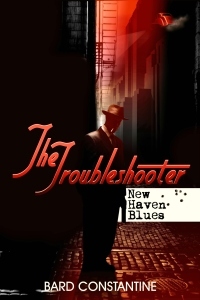 The humble beginning.
The humble beginning.
Published on June 22, 2012, the hastily-written McGuffin chase introduces Mick Trubble, a private eye in a dystopian future where remnants of humanity survive the unexplained Cataclysm and reside in Havens. The story barely holds together, and small wonder: the concept was born out of a tongue-in-cheek writing exercise in a now-defunct social media site for writers. I wrote in my online peers as characters in a goofy little detective story and loved it so much that I later turned it into a full-length novel, providing a shaky start to what would become the Troubleshooter series.
New Haven Blues was a cartoon, a Dick-Tracy world full of eccentric characters and half-baked ideas. The best thing to emerge from the novel was the atmospheric city itself: New Haven, a melting pot of noir contrasts blended with Blade-Runner Los Angeles sensibilities. And, of course, Mick Trubble: the title character who carries the nonsense of the novel on with charisma and dry wit. Readers seemed to forgive the inconsequential plot and cardboard characters because Mick was a likable protagonist, someone worth giving another shot in his follow-up stories.
I didn’t get into the swing of things until Red-Eyed Killer, the follow-up novella. Together with three other short works, Four Shots defined the Troubleshooter, giving Mick gravity and establishing his moral code far better than New Haven Blues. By the time I wrote The Most Dangerous Dame, I was comfortable with who Mick was and how his world worked. Unfortunately, that left New Haven Blues out of sorts with the rest of the stories, a disjointed debut novel that didn’t flow with the sequels. After a while, I knew what I needed to do.
I had to George Lucas the crap out of it.
While plotting the latest installment, I finally resolved the dilemma with the character of Hunter Valentino—introduced in New Haven Blues as essential to Mick’s story. That meant going back to New Haven Blues and doing some minor retconning, along with some cohesive restructuring. One major character—the Cowboy—was eliminated because he added nothing to the narrative. Another character—La Fox—was expanded because of her ties to the Nimrod Squad novels and important interaction with Mick. Major editing was applied to the text, correcting errors and improving dialogue. The result was an improved version of the same story. Although plot-wise it’s still the most problematic installment of the series, I have a strange affection for it. I think it’s the best I could make it without napalming the entire novel.
If you’re a fan of New Haven Blues, no worries: the main plot and characters remain intact. You might even like this version better. If you’re like me and felt like it needed some improvements, I’m sure you’ll enjoy the changes in Edition II.
Either way, you don’t have to pay again to read the updated version. Pick up the eBook for free here. And whether you’re a Troubleshooter fan or new to the game, thanks for your support. I hope you enjoy the read!
March 31, 2019
New Release: Nimrod Squad
I’m very happy to announce the first release of this year for my personal imprint, BWB Publishing. Not only did I have a blast writing Nimrod Squad, but I also was able to stick to my writing schedule and get this novel out on time for a March release. (Just barely, but did it!)
So what is Nimrod Squad about? It’s a fast-paced action adventure following the exploits of four misfits who ultimately band together to become Nimrods, as bounty hunters are called in Havenworld. There’s Cash Murdock, a former cop who trusts no one except his AI companion Deejay; Mateo Lonergan, a young warrior whose wide-eyed naivety is matched only by his lethal fighting skills; Jinx la Fox, a talented hacker and thief with a knack for making powerful enemies, and Happy, a gun-for-hire with a scarred face and a bad attitude who can’t outrun her mysterious past.
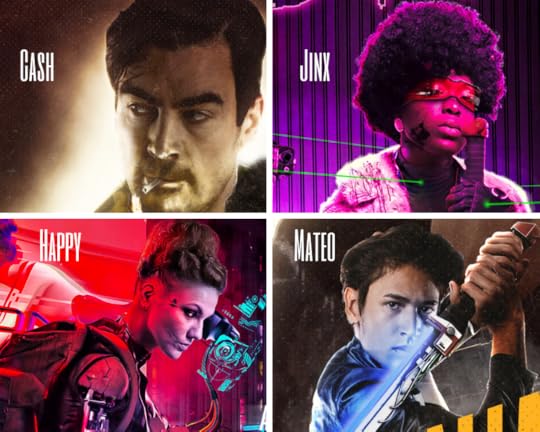 Cover art by J Caleb Design
Cover art by J Caleb Design
When a massive bounty is posted for a rogue general and his rebel army, the above individuals are forced to work together, but can they overcome their mutual distrust to overcome the odds against them? They’ll find out over a caper that involves breaking into the most advanced Haven in the country, creating an uneasy alliance with a Special Agent assigned to bring them in, and going up against Kilgore: the most dangerous killer alive.
Nimrod Squad is greatly inspired by my favorite anime, Cowboy Bebop, along with other misfit adventure stories like Guardians of the Galaxy. There’s something satisfying about creating these flawed characters and bringing them together to form an unlikely family of sorts. The character dynamics were fun to create, and even I was surprised by what some of the characters did and where they wound up by the end of the tale.
I think you’ll get a kick out of Nimrod Squad if you’re a fan of the aforementioned influences and similar stories. The book releases on 3/31/19 and can be purchased at Amazon. More info can be found on the official website. Hope you get a chance to check it out. Meanwhile, please enjoy the promotional video below!
March 11, 2019
Evolution of a Cover: Nimrod Squad
The design of a cover is an exciting process, and I’m sharing a peek behind the scenes. In this article, the cover in question is Nimrod Squad, my tale of a dysfunctional crew of bounty hunters.
The cover started off as a premade designed by J Caleb Clark of J Caleb Design, whose fantastic work I can’t recommend enough. What’s a premade? It’s when the designer creates a cover for a specific genre, puts mock title and author fonts on it, and then presents it for sale. It allows them to work free of constraint and create whatever their imagination impels. More often than not, authors find premades to fit a story they have in mind. They purchase the premade, relay their title info to the designer, and get their new book cover. Most designers are willing to make small changes to the premade to better fit the author’s vision. But be aware that additional charges may incur should you want to do so.
This is the premade cover I purchased from Jake:
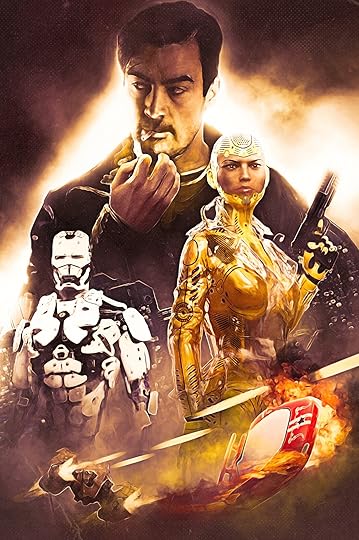
Very impressive work. Just the type of throwback sci-fi pulp action that I enjoy writing. I was instantly drawn to the dynamic, B-movie poster style of the art and knew it would be a perfect fit for my Nimrod Squad concept. I purchased it and made a request: I wanted the woman’s face to be more realistic, so I found and bought a stock image of the model I wanted to use. I also wanted her to have a punk look so I asked Jake if he could style her hair with a cyberpunk attitude. He obliged and updated the look:
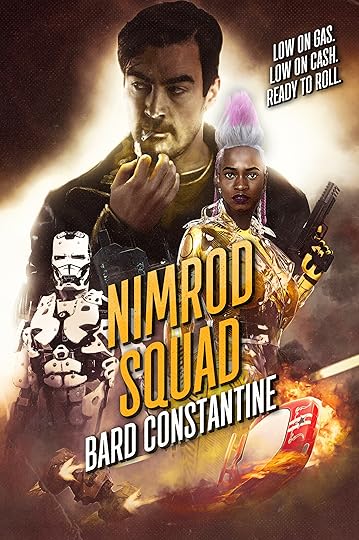
So the final version looks good, right?
Ok, maybe that wasn’t the final version. A few months later I purchased another premade from Jake for a future novel. I realized the look of the character would be perfect for Jinx la Fox, the hacker on the cover of Nimrod Squad. So once again I went to Jake to pester him for a change and update. He happily obliged.
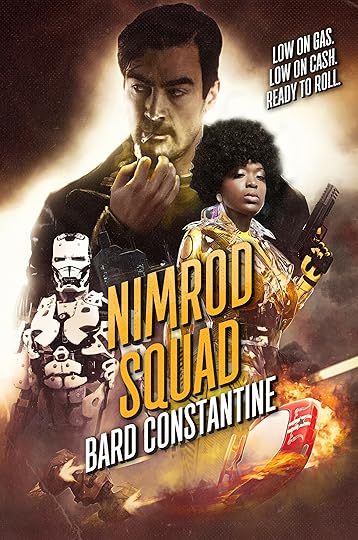
And look at that: even better than before. I finally had a cover that perfectly reflected what I wanted for the story. Right?
Err…
Let me clarify by saying that I had not written the book when I bought the cover. And even after making the changes I was still in the writing process. As the book progressed, the characters came to life and evolved. And lo and behold, I had one more idea for the cover. Once again I went to Jake to nag him about swapping out the robot with a different character. I wanted to feature Mateo, my young swashbuckler who uses a very unique weapon. I purchased the stock and talked with Jake about designing the cyber sword. Would he be up to the challenge? See for yourself.
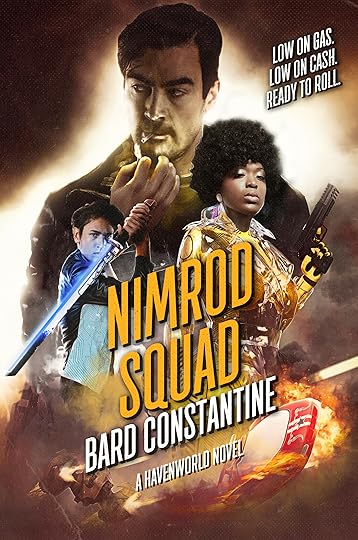
There you have it. I really couldn’t be happier with the results and want to give a huge should out to J Caleb Clark for his professionalism, impressive design skills, and the patience to deal with a bothersome customer like me. I’m in your debt, man. Can’t wait to show off many of the other premades I’ve purchased from you in future articles.
If you’re reading this and want to work with Jake, here’s the website: https://www.jcalebdesign.com
Tell him Bard sent you!
Some tips: this isn’t exactly a typical experience, so don’t expect every designer to be so accommodating. Many designers, Jake included, are on tight schedules and are regularly booked for work. It’s always best to know exactly what you want upfront. Preferably after the book is finished, lol. Fortunately, I’ve worked with Jake more than a few times, so he was able to give me some leeway.
I mentioned purchasing stock for the modifications. While designers can buy stock for you, I find it’s best to buy my own. That way I choose the exact model and pose I want, and there’s no confusion to bog down the process. I’ll post more about stock purchasing in a future article. If you have any questions, you can ask in the comments, and I’ll be happy to answer them for you.
Oh, and if you want to give Nimrod Squad a shot, you can check it out here. Thanks!

